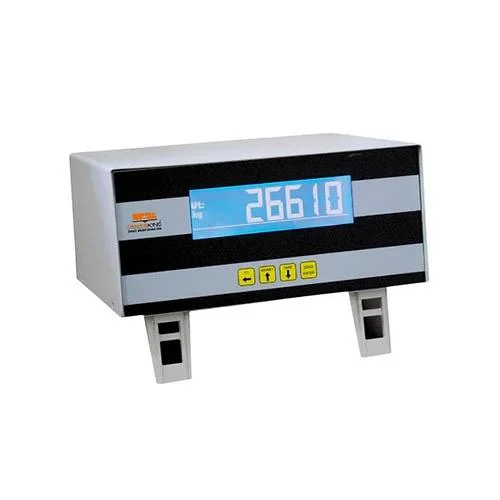What Is a Weight Indicator and Why It Matters in Weighing Systems?
- Kanta King

- Nov 4
- 4 min read
When you think about a weighing system, what usually comes to mind? Most people picture the weighbridge, the load cells, or maybe even the truck standing on it. But there’s one crucial component that silently does all the hard work of interpreting, displaying, and managing the weight data — the weight indicator.

While it might look like a small box with a digital display, the weight indicator is truly the brain of any weighing system. It connects the physical measurement (from load cells) with the digital world of data and decision-making. Let’s understand what a weight indicator is, how it works, and why it plays such a vital role in modern weighing operations.
What Is a Weight Indicator?
A weight indicator, sometimes called a digital indicator or weighing terminal, is an electronic device that receives signals from load cells — the sensors that detect force or weight. It processes these signals and converts them into readable numbers, typically showing the total weight on a screen.
In simpler terms, if load cells are the muscles of a weighing system, then the weight indicator is its brain and voice — interpreting raw data and telling you exactly how much weight is on the scale.
But a modern weight indicator does much more than just show numbers. Depending on its type, it can store data, communicate with computers or printers, and even integrate with software like ERP or inventory management systems.
How Does a Weight Indicator Work?
The process is quite fascinating. Here’s a simplified breakdown:
Load Detection: When a vehicle or object is placed on the scale, the load cells sense the pressure and generate small electrical signals proportional to the weight.
Signal Transmission: These signals, which are in millivolts, are too weak to be understood directly. They travel through shielded cables to the weight indicator.
Signal Amplification and Conversion: The indicator amplifies these weak signals and converts them from analog to digital form.
Display and Processing: Finally, the indicator processes this data and displays the weight digitally on its screen — in kilograms, tonnes, or any other chosen unit.
Modern indicators also have microprocessors and AI-based algorithms that help filter out electrical noise or vibration effects, ensuring highly accurate readings even in tough industrial environments.
Types of Weight Indicators
Weight indicators come in different designs based on their purpose and the complexity of the weighing system.
Basic Indicators
Used for simple applications like floor scales or bench scales.
Display basic weight readings and may include simple functions like tare, zero, and print.
Advanced Indicators
Designed for weighbridges or industrial automation setups.
Support data logging, multiple load cells, remote display, and communication through Ethernet, USB, or RS232.
Some can directly integrate with ERP or weighbridge management software.
Smart or IoT-Based Indicators
These are the new-age devices redefining weighing efficiency.
Equipped with Wi-Fi, Bluetooth, and cloud connectivity.
Allow real-time monitoring, predictive maintenance, and even remote calibration.
Why Weight Indicators Matter in Weighing Systems?
A high-quality indicator is not just an accessory — it’s a core component that determines how reliable and efficient your entire weighing system is. Here’s why it matters:
1. Accuracy and Reliability
The precision of your weighing depends on how well your indicator interprets the signal from the load cells. A poor-quality indicator can lead to incorrect readings, financial loss, and even compliance issues.
2. Data Recording and Traceability
Modern industries demand data-driven decision-making. Indicators with inbuilt memory or connectivity allow automatic recording of each weighing session — including date, time, operator ID, and weight — ensuring complete traceability.
3. Operational Efficiency
Weight indicators reduce human intervention. By automating weighing and data transfer, they minimize manual errors and speed up operations — which is especially important in logistics, mining, and manufacturing sectors.
4. Integration and Connectivity
From RFID systems to ERP platforms, today’s weighing operations require seamless integration. Advanced indicators enable this by supporting multiple interfaces — ensuring that every truck entry, exit, and transaction is automatically logged into your digital system.
5. Compliance and Certification
Many industries follow OIML or NTEP standards for weighing equipment. Certified weight indicators ensure that your system meets legal and trade accuracy standards — protecting your business from penalties and disputes.
The Future of Weight Indicators
As the world moves towards smart weighing systems, indicators are evolving rapidly. The latest models feature:
AI-based analytics for predicting errors or maintenance needs.
Touchscreen displays for easier operation.
Cloud-based dashboards that allow you to monitor weight data from anywhere.
Integration with mobile apps, giving real-time alerts and reports.
In short, the indicator is no longer just a display — it’s becoming a complete data intelligence hub for the weighing industry.
Kanta King’s Commitment to Smart Weighing
At Kanta King, we understand that a weighing system is only as strong as its brain — the indicator. That’s why we offer precision-engineered digital weight indicators designed for Indian conditions.
Our indicators combine robust hardware, accurate signal processing, and smart connectivity, ensuring consistent performance in even the harshest industrial environments.
Whether you run a weighbridge, a batching plant, or a warehouse — Kanta King’s advanced indicators help you get accurate, fast, and reliable results every single time.
Conclusion
A weight indicator might look like a small part of a weighing system, but it’s the component that ties everything together — from load cells to data analytics. It ensures that every reading is precise, every transaction is transparent, and every operation runs smoothly.
So, the next time you look at that glowing digital display on a weighing machine, remember — it’s not just showing numbers. It’s powering decisions, efficiency, and trust across industries.
KANTA KING
Website: https://www.kantaking.com/
Contact Us: +91.9560915555
Email: info@kantaking.com




Comments